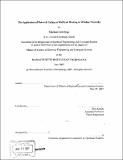| dc.contributor.advisor | Dina Katabi. | en_US |
| dc.contributor.author | Jennings, Michael (Michael Vincent) | en_US |
| dc.contributor.other | Massachusetts Institute of Technology. Dept. of Electrical Engineering and Computer Science. | en_US |
| dc.date.accessioned | 2008-02-27T22:44:20Z | |
| dc.date.available | 2008-02-27T22:44:20Z | |
| dc.date.copyright | 2007 | en_US |
| dc.date.issued | 2007 | en_US |
| dc.identifier.uri | http://hdl.handle.net/1721.1/40532 | |
| dc.description | Thesis (S.M.)--Massachusetts Institute of Technology, Dept. of Electrical Engineering and Computer Science, 2007. | en_US |
| dc.description | Includes bibliographical references (p. 58-62). | en_US |
| dc.description.abstract | This thesis considers the application of network coding and opportunistic routing to improve the performance of multicast flows in wireless networks. Network coding allows routers to randomly mix packets before forwarding them. This randomness ensures that routers that hear the same transmission are unlikely to forward the same packets, which permits routers to exploit wireless opportunism with minimal coordination. By mixing packets, network coding is able to reduce the number of transmissions necessary to convey packets to multiple receivers, which can lead to a large increase in throughput for multicast traffic. We discuss the design of a multicast enabled variant of MORE, a network coding based protocol for file transfer in wireless mesh networks, and evaluate this extension, which we call MORE-M, in a 20-node indoor wireless testbed. We compare MORE-M to a wireless multicast protocol that takes an approach similar to that of wired multicast by using the ETX metric to build unicast routing trees. We also compare MORE-M to a multicast enabled variant of the ExOR routing protocol. Experiments show that MORE-M's gains increase with the number of destinations, and are 35-200% greater than that of ExOR. We then consider the problem of video streaming in a wireless local area network for applications such as video conferencing. A network coding based protocol that uses opportunistic receptions at clients is proposed. We evaluate the design in our testbed and demonstrate that the use of network coding and, in particular, the use of wireless opportunism increase the quality of the video stream. | en_US |
| dc.description.statementofresponsibility | by Michael Jennings. | en_US |
| dc.format.extent | 62 p. | en_US |
| dc.language.iso | eng | en_US |
| dc.publisher | Massachusetts Institute of Technology | en_US |
| dc.rights | M.I.T. theses are protected by copyright. They may be viewed from this source for any purpose, but reproduction or distribution in any format is prohibited without written permission. See provided URL for inquiries about permission. | en_US |
| dc.rights.uri | http://dspace.mit.edu/handle/1721.1/7582 | |
| dc.subject | Electrical Engineering and Computer Science. | en_US |
| dc.title | The application of network coding to multicast routing in wireless networks | en_US |
| dc.type | Thesis | en_US |
| dc.description.degree | S.M. | en_US |
| dc.contributor.department | Massachusetts Institute of Technology. Department of Electrical Engineering and Computer Science | |
| dc.identifier.oclc | 191913971 | en_US |
